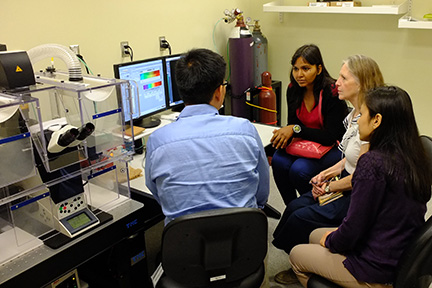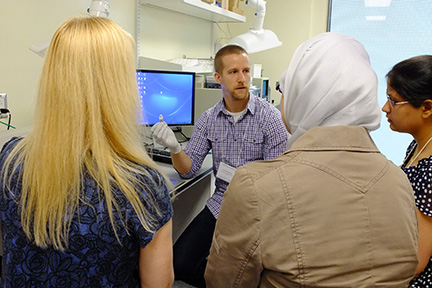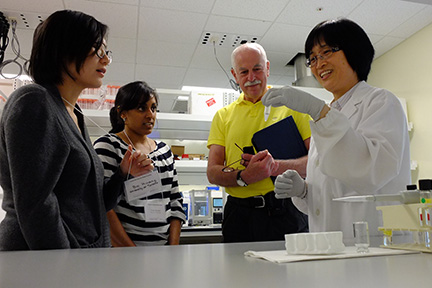September 4, 2014

Attendees gather around Dr. Guobin Sun for a white light laser scanning confocal microscopy demonstration.
The Centre for High-Throughput Phenogenomics welcomed researchers from six Canadian universities this past July in its first summer institute. The Centre is a top-tier imaging facility in the Faculty of Dentistry at the University of British Columbia. It houses scanning electron microscopy, optical imaging, X-ray imaging, and mass spectroscopy modalities.
Nine participants—mostly young investigators—from the universities of Laval, Toronto, Manitoba, Alberta, British Columbia, and Western University (London, Ontario) were given the opportunity to garner a complete picture of new and innovative imaging capabilities specifically geared toward integrating them in their oral and craniofacial basic science research.
The summer research institute, titled “Advanced Imaging Methods in Craniofacial and Oral Health Research,” ran from July 14 to 18 and was sponsored by the Network for Canadian Oral Health Research. Corporate sponsors included Systems for Research, FEI Company and Scanco Medical.
Covering a broad range of imaging modalities, participants attended scientific and technical lectures, gained hands-on experience in laboratory-based workshops and had access to application specialists from major manufacturers of imaging technology. The week-long program also included talks about research funding and research translation. “This wide range program suited the group because most participants came with a narrow exposure to what is available in advanced imaging or a single-focus using a specific technology,” explains Dr. Nancy Ford, director of the Centre at UBC.

During a laboratory-based workshop on optical projection tomography, John Schipilow prepares a sample for imaging.
The goal was to “get people thinking more about imaging,” Ford says, “and I believe this was achieved.” She recalls one participant, Dr. Bo Huang, a PhD candidate from the Faculty of Dentistry, University of Toronto, who after listening to scientific and technical sessions on optical microscopy, phoned her supervisor in Toronto to ask about capabilities of imaging techniques at her home institute.
“We geared the program to foster a transfer of skills and at the same time create an environment for participants to seek out a bigger vision for their research and an increased understanding of both capabilities and limitations of equipment and procedures depending on their particular specimen samples,’ Ford says. Back in Toronto, Huang has shared her experience and knowledge with colleagues, and for her, someone who is just starting her project and working with imaging systems, attending the summer institute was “the perfect guide”. She hopes more PhD students can attend in the future which, in her words, would “help them to kick off their research.”
Networking also played a significant role for participants—among themselves from different institutes, and with the scientific speakers, technical representatives from equipment manufacturers and technicians from the Centre.
After participating in the summer research institute Dr. Yara Kareen Hosein, a postdoctoral fellow from Schulich School of Medicine and Dentistry, Western University, regarded the effectiveness of the program format which gave her a comprehensive understanding of the various imaging modalities. “Having completed the sessions, I am now aware of the diverse imaging tools available to improve my research capabilities. In addition, the presentations on technology translation and research funding were a good inclusion to the program, since they were very much applicable to early stage researchers.”

Shujun Lin discusses sample preparation techniques for imaging using the MALDI mass spectrometer.
About the Network for Canadian Oral Health Research
The NCOHR is the primary resource for initiating, supporting, and sustaining innovative and collaborative oral health research designed to benefit the health of all Canadians.
Visit www.ncohr-rcrsb.ca for more information.
About the Centre for High-Throughput Phenogenomics
The CHTP is an advanced imaging facility offering a comprehensive suite of technologies that collectively provides two- and three-dimensional information and analysis about the structure of specimens using scanning electron microscopy, optical imaging, X-ray imaging and mass spectroscopy. The Centre operates as a core imaging facility, open to researchers from a variety of fields and is available to researchers across North America.
Visit www.phenogenomics.dentistry.ubc.ca for more information.
About the NCOHR 2014 Summer Research Institute
Scientific speakers from UBC included Drs. John Abramyan, Don Brunette, Nancy Ford, Juergen Kast, Hugh Kim, Alan Lowe, Neil Mackenzie, Fabio Rossi, Ed Putnins, Charles Shuler, Zhejun Wang, Sam White, and Chris Wyatt; and from the University of Washington, Dr. Murat Maga.
From the Centre for High-Throughput Phenogenomics, laboratory-based workshops were conducted by Shujun Lin, Dr. Gethin Owen, John Schipilow, and Dr. Guobin Sun.
Equipment manufacturer presenters were Rasesh Kapadia, Gabriella Kiss, Reg Sidhu, and Christian Wietholt.
For more details about the NCOHR 2014 Summer Research Institute, view the program.